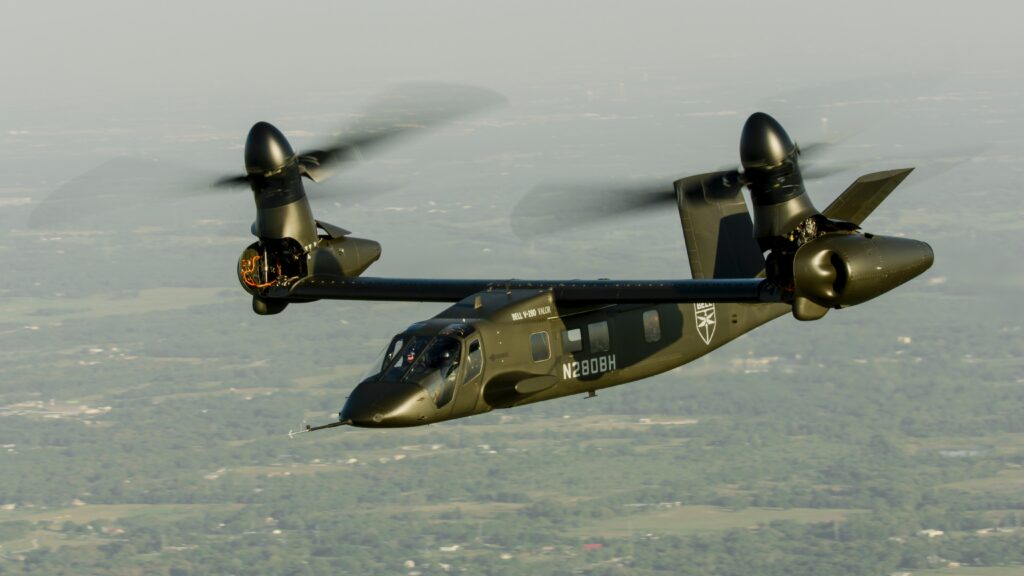Tiltrotors Set to Revolutionise UK Army Aviation: FLRAA's Impact on Industry

The introduction of tiltrotor technology, a novel aircraft type for the British Army, is set to bring about a "step-change" in both operational capabilities and the wider defence industrial base. This is particularly true for the Bell Future Long Range Assault Aircraft (FLRAA), a project that is currently in its development phase.
Breaking Defence spoke with Ryan Ehinger, senior vice president and program director for FLRAA/V-280 Valor at Bell, to discuss the program's progress and the implications for the UK defence sector.
Milestone B Achieved: Entering the Next Phase of Development
The recent announcement that FLRAA has reached Milestone B marks a crucial stage in the acquisition process. Ehinger explained that this milestone paves the way for the engineering and manufacturing development (EMD) phase. The government and industry have been collaborating for a decade to refine requirements and mitigate risks, and the EMD phase will focus on solidifying digital models, finalising hardware and software designs, and refining sustainment processes. This phase is critical for ensuring complete alignment before the program progresses to the manufacturing and testing of prototype FLRAA aircraft.
A Collaborative Effort: Bell and its Industry Partners
Bell has chosen a network of companies across the defence industry to support the development of FLRAA. Ehinger highlighted this partnership as a key component of success, with a shared commitment to meeting the Army's acquisition and sustainment goals. While Bell retains a significant level of internal integration, it is the collaboration with industry leaders across the supply chain that ultimately delivers the final weapon system.
Transforming Operations, Support, and Training
The introduction of the tiltrotor aircraft offers significant operational advantages. Its speed and range surpass the existing fleet, providing the British Army with expanded manoeuvrability, greater mission efficiency, and a reduction in overall flight hours required to complete missions. The unique combination of vertical lift, speed, and range has proven invaluable in both combat and humanitarian operations.
From a support and training perspective, the tiltrotor systems, such as drive systems, rotors, airframes, and hydraulics, offer a degree of familiarity to existing rotorcraft maintainers. The systems are integrated in a novel way, incorporating advanced on-board health monitoring that optimizes maintenance actions. Digital engineering plays a key role, bridging the gap between engineering data and maintenance records, enhancing training, maintenance, and record-keeping processes.
A Boost to the UK Defence Industry
The production of tiltrotor aircraft at scale for FLRAA represents a significant boost to the UK defence industrial base, extending beyond Bell's supply chain to encompass the broader global network. The program is a rare opportunity for the development of a new aviation program, offering a chance to integrate cutting-edge manufacturing technologies into a clean-sheet design.
This approach, incorporating digital engineering, manufacturing advancements, and scaled automation, propels the UK industrial base forward by introducing new and more efficient methods of engineering, manufacturing, and inspection. The global supply base is presented with an opportunity to achieve improvements in affordability, lead times, and quality, while establishing a new foundation for manufacturing that will continue to evolve throughout the aircraft's lifecycle.
The Impact of Digital Engineering and Manufacturing
FLRAA's clean sheet design and its reliance on new manufacturing technology and digital engineering have significant implications for the industrial base and the supply chain. By leveraging these advancements, the program aims to achieve improvements in affordability and quality. The digital thread, connecting engineering to manufacturing, assembly, and inspection, eliminates redundancy and reduces the risk of data errors.
Supply Chain Quality and Risk Management
The British Army places a high priority on manufacturing quality within the supply chain for FLRAA. This focus reflects a recognition that the program's success is reliant on the contributions of each individual supplier. Bell is committed to incorporating lessons learned from previous platforms, employing efficient manufacturing processes, automation, and repeatable processes to enhance overall quality.
Supply chain risk management is crucial for maintaining a robust production line. Long lead times for aviation components and the high costs associated with mid-production changes necessitate a proactive approach to mitigating risks.
Conclusion
The introduction of the tiltrotor aircraft and the ongoing development of FLRAA present significant opportunities for the UK defence industry. The program is poised to reshape operational capabilities while simultaneously driving innovation and technological advancement within the industrial base. The emphasis on collaboration, digital engineering, and quality assurance promises a more robust and efficient future for the UK defence sector.





